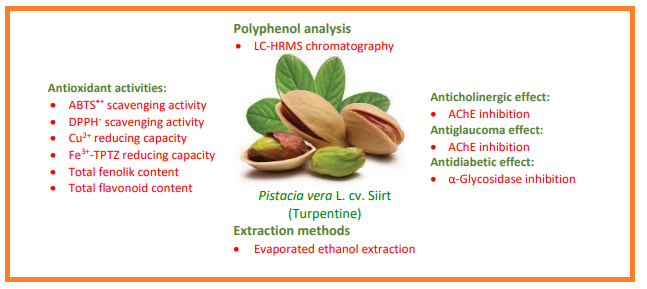JOURNAL 2787
Records of Natural Products
Year: 2023 Issue: 5 September-October
p.918 - 937
Viewed 1293 times.
GRAPHICAL ABSTRACT

ABSTRACT
Pistacia species containing turpentine which has protective effects and used as a medicine against diabetes, and infections for a long time. To interpret the antioxidant capacities of turpentine from Pistacia vera L. cv. Siirt, 2,2’-azino-bis-3-ethylbenzthiazoline-6-sulphonic acid radical (ABTS•+) and 1,1-diphenyl-2-picrylhydrazyl free radical (DPPH∙), Fe3+-2,4,6-tris(2-pyridyl)-S-triazine (TPTZ) and Cu2+ reducing ability were studied and compared to reference antioxidants of BHT, BHA, α-Tocopherol, and Trolox. The IC50 of turpentine for ABTS•+ and DPPH∙ scavenging capacities were determined to be lower than reference antioxidant standards as 231.1 μg/mL and 346.6 μg/mL, consequently. The total flavonoid and phenolic contents in turpentine were measured as 12.5 mg GAE/g and 38.852 mg QE/g, respectively. For determination of antidiabetic, anti-Alzheimer, and antiglaucoma effects of turpentine, acetylcholinesterase (AChE), α-glycosidase and carbonic anhydrase II (hCA II) enzymes inhibition abilities of turpentine were performed, respectively. The IC50 values of turpentine extract against α-glycosidase, hCA II, and AChE enzymes were found as 2.04, 3.59 and 14.6 µg/mL, respectively. The quantity of protocatechuic acid and naringenin were determined using LC-MS/MS against 53 standards. The results clearly demonstrated polyphenolics in P. vera L. cv. Siirt turpentine is a natural product has potential usage in amelioration of glaucoma, AD, diabetes, and epilepsy.
KEYWORDS- Phenolic compounds
- turpentine
- antioxidant
- α-glycosidase
- acetylcholinesterase
- carbonic anhydrase